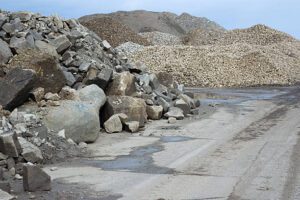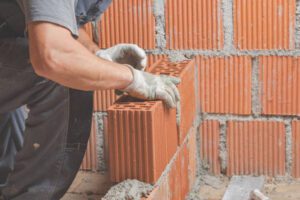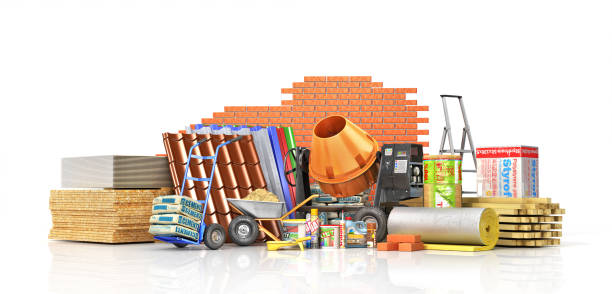Any substance used to construct a structure is referred to as a building material. The construction business uses a variety of materials for construction. Depending on their structural capacity, we employ various materials. Building materials used in construction are governed by regional and national standards. On the other hand, architects select building materials based on cost and beauty. By selecting the best material for your project, you may improve and extend its lifespan. Below is a list of some of the most typical building supplies.
Concrete
 (Photo from iStock)
(Photo from iStock)
A very popular building material is concrete. It is made of a composite substance that combines cement and water with fine and coarse aggregate as a binder. Then allowed to cure and set for a while. In general, concrete needs 28 days to reach its optimum strength after seven days of curing. Concrete that has steel inserted in it to boost the structural tensile strength is known as reinforced concrete and is most frequently used in construction.
Concrete is available in a variety of forms, including waterproof and light-weight varieties. The kind of concrete used is determined by the kind of project. The ability to pour concrete into any form and have it cure into a material resembling stone is one of the material’s greatest benefits.
Concrete is a widely used material in construction due to its low cost and adaptability. Concrete is utilized for
- Foundations
- building residential structures
- development of commercial structures
- construction of bridges
- sewers and culverts.
Steel for building
 (Photo from iStock)
(Photo from iStock)
As a result of our discovery of steel as a reinforcement material, the building of skyscrapers exploded. Steel is highly functional and strong. In comparison to other building materials, it is also less expensive to freight, lightweight, and simple to deal with. Steel does not easily deform unless we apply a lot of weight to it, and even when bent, it maintains its structural integrity.
Steel stands out thanks to its great strength to weight ratio. Compared to concrete, it takes less time to install, and we can do it anywhere. However, corrosion might occur if steel is not fitted properly. Steel’s propensity to degrade at high temperatures is one of the material’s major disadvantages for use in building. The type of steel determines how fire resistant it is.
The following are some common uses of steel in construction:
- To boost the tensile strength of structural parts, we employ steel as reinforcing bars.
- We utilise it to create interior fixtures like railings and stairs.
Wood
 (Photo from iStock)
(Photo from iStock)
It is readily available, economical, powerful, long-lasting, and flexible in every way. You shape them according to your own choices and enjoy that process.
In addition to being durable, wood is an environmentally friendly material. Steel, stone, and aluminium all operate well with it. Wood is relatively lightweight and straightforward to standardize in size when compared to other building materials. It is effective in insulating and soundproofing, and it has a high tensile strength.
In the following sectors of building, we employ wood:
- Building of the ceiling, floors and walls
- building interior features including door and window frames
- structures’ frames in buildings and bridges
- Thermal defence
- acoustical protection
Stone used for building
 (Photo from iStock)
(Photo from iStock)
The most durable building material is stone. It is available in a wide range of colours and finishes, from smooth to rough. Although common stone is inexpensive, expensive finishes are available. Quality and colour affect the price and length of manufacture for marble countertops.
Stone has some shortcomings. Because of its weight and the impact of its density, moving it is challenging. Stone is a poor insulator as well, making it useless for insulation in cold climates.
In the following ways, stone is used in construction:
- as a construction-related rough aggregate
- For walls, dams, and bridge piers in masonry
- as railway ballast
- To prevent dampness on exterior walls
- Marble and other stones make superb polish finishes.
Bricks
 (Photo from iStock)
(Photo from iStock)
Despite having a great compression resistance, they are easily breakable. Durable and fire-resistant is masonry. We utilise it to build load-bearing walls due of its strong compressive strength. Masonry can support multi-story structures when reinforced with concrete, making it a cost-effective material for construction.
Masonry is used in a variety of building materials, including:
- applied to walls
- used to construct masonry foundations
- In places that are prone to flooding, gabion building also uses masonry.
Construction foam for building
 (Photo from iStock)
(Photo from iStock)
Unique and having a high strength-to-weight ratio is bamboo. Furthermore, Its strong tensile strength and compressive strength are comparable to those of concrete, brick, and wood. This is a tough alternative that one should adhere to.
To prevent air intrusion and offer thermal insulation, buildings use this plastic foam material.
Glass
 (Photo from iStock)
(Photo from iStock)
Glass is more aesthetically pleasing and lighter than brick and masonry. Durable building materials are a fundamental requirement for commercial construction projects. First and foremost, concrete stands as a stalwart option, offering unrivalled strength and longevity. Additionally, steel reinforcement bolsters concrete’s resilience, ensuring stability in high-stress areas. Moreover, the use of steel-framed structures provides excellent load-bearing capacity, which is imperative in commercial construction.
Conclusion
Transitioning to exterior materials, brick and stone offer timeless durability while adding an aesthetic touch. Furthermore, the use of high-quality glass for windows not only contributes to a building’s energy efficiency but also guarantees long-term clarity and resistance to environmental factors. When discussing roofing materials, durable options such as metal or synthetic slate prove essential for protection against the elements. Likewise, composite materials, like fibre cement, make for exceptional siding choices due to their resistance to rot and insect damage. In conclusion, in the world of commercial construction, the selection of durable building materials is paramount, and the careful transition from foundation to façade ensures that structures can withstand the test of time while meeting safety and aesthetic standards.




